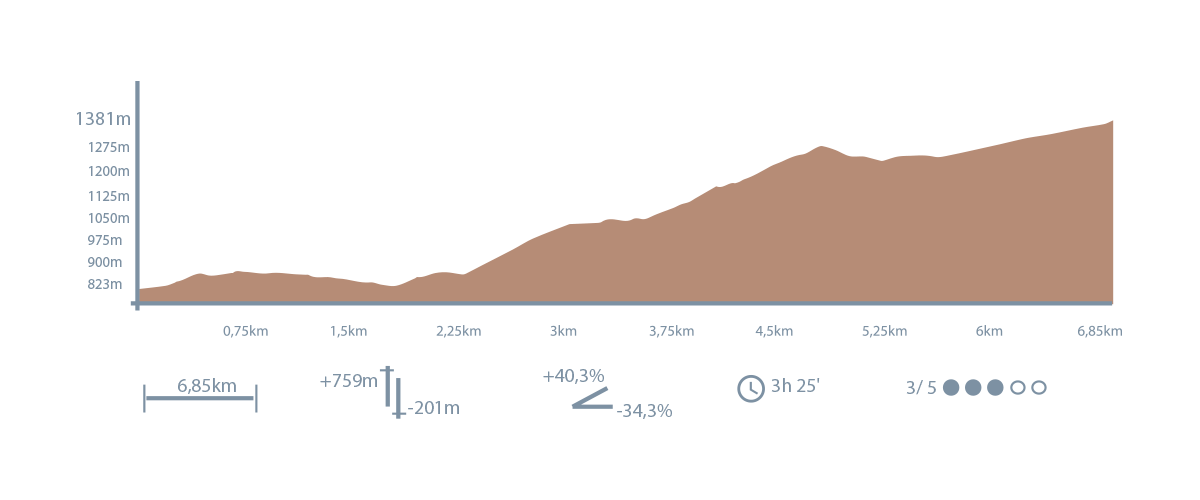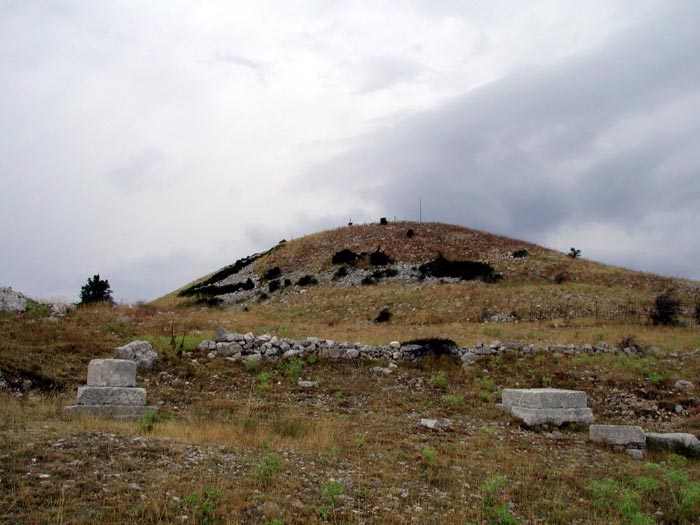Project Description
4. The Sacred Trail
Abeliona - Agios Sostis - Likaio Mnt
This trail connects Abeliona with the peak of Lycaeus Mountains.
In ancient times the Arcadians considered it a sacred mountain, one at a time, and there they believed that Zeus was born. The name Lycaeon is derived from the ancient root of lyc (lux in Latin), which means light. The Arcadians also named Olympus Lycaeus and Crete the Holy Top and believed this to explain the misunderstanding of the Cretans, who thought Zeus was born in Crete (Pausanias VIII.38.2).
At this peak there have been worship activities since the third millennium BC. and continued uninterruptedly until the Hellenistic years. Pausanias mentions the existence of an altar of Zeus at this peak, suggesting that human sacrifices might have taken place there (Pausanias VIII.38.7 – modern research has not confirmed this hypothesis). On a plateau, south of the summit, there was the mosque of Zeus. It was rather a mere cult enclosure, with no monumental character. Today, in this area, there is the small chapel of Prophet Elias of Ano Karyotes. To the east of the altar, a short distance from the chapel, are the bases of the two columns mentioned by Pausanias (VIII.38.7).
Since 2004, excavations have been carried out in the area of the altar and the mosque, as well as in the Lycaean, music and gymnasiums of the Olympics, in collaboration with the Arcadia Antiquities Board and the American School of Classical Studies. Excavations have brought to light important findings that attest to the ancient origin of both worship activities and struggles.
On the initiative of the Cultural Association “The Lyceum of Zeus” of Ano Karyotes, the ancient Lyceans have been revived since 1973. The games are held every four years and in 2021 will be held for the 13th time.
The view from the top of Lycaeus Mountains is stunning. Τhe three quarters of the Peloponnese and some Ionian islands appear. Next to the traces of the ancient worship of Zeus and surrounded by the silence of the impressive landscape, the visitor, if he is lucky, may have the feeling that the place vibrates with a cunning and mysterious energy.

Details
| 6.9 km | 3h 25‘ | 3/5 |
Starting point: Abeliona
Ending poind: Likaio Mnt
Main sights: Abeliona, Agios Sostis, Altar of Zeus
Connected to: 5. Trail of Bliss
Trail description
The route starts from Abeliona, from the “Spyros’ Traditional Tavern”, and proceeds to the entrance of the village, where the Trani Fountain with its four valves is located (“Kubles”). From there, the steps lead to the Abeliona Retreat. Leaving behind the hostel, the trail climbs gently, in an area of dense mixed vegetation and rich shade, until it reaches the asphalt road leading to the village of Agios Sostis. After crossing Agios Sostis, through cobbled streets, the trail begins to climb to the west slope of Lycaeus. The route is steeply uphill, for the most part, but the hiker is compensated as the view westward, step by step, becomes more and more impressive.
Shortly before the end of the climb, we will meet the Neruli fountain, in an area of dense clumps of holly. Its cool water flows into a wooden “knob”. Then the path crosses a small plateau, with terraces, threshing floors and ruined huts, while in the background dominates, in its hemispherical shape, the peak of the Lycaeus Mountains, the Arcadian Top, the birthplace of Zeus.
The last part of the route follows a rural dirt road, to the site of the mosque of Zeus. At this point we will see the chapel of Prophet Elias of the Upper Karyotes, as well as the bases of the two columns to which Pausanias refers (VIII.38.7). At the top, a little higher, leads uphill to a few tens of meters. There, at the altar of Zeus, we will see traces of excavations carried out in recent years and enjoy a breathtaking view – three quarters of the Peloponnese and some Ionian islands are visible.
Sightseeing spots
Abeliona
Built on the notorious crossroads of three counties, Arcadia, Ilias and Messinia, Abeliona is a traditional mountain village surrounded by chestnut forests and innumerable natural springs. Cobblestone streets and old stone houses, hiding images, sounds and scents from another era, reveal themselves for a moment, before the fresh, mountainous air drifts away. A place that turns simple daily delights, into unique experiences that you want to experience again.
Agios Sostis
A picturesque village on the western slopes of Lycaeus. The Neda tributary, which crosses the village, originates from the its source spings “Kefalari”. In Agios Ioannis, at the north end of the village, the most important festival of the region takes place every year on August 29th.
Altar of Zeus
The altar of Zeus at the Arcadian Sanctuary. At this peak, according to the Arcadian version of the myth, Zeus was born. The name Lycaeon is derived from the ancient root of lyc (lux in Latin), which means light. The Arcadians also named the holy peak as Olympus Lycaeus and Cretea, and it is believed that this explains the misunderstanding of the Cretans, who thought Zeus was born in Crete (Pausanias, VIII.38.2).
At this peak there have been worship activities since the third millennium BC, and were continued uninterruptedly until the Hellenistic years. Pausanias mentions the existence of the altar and suggests that there may have been human sacrifices (Pausanias VIII.38.7 – modern research has not confirmed this hypothesis). On a plateau, south of the peak, there was the mosque of Zeus. It was rather a mere cult enclosure, with no monumental character. To the east of the altar, just a short distance from the mosque, are the bases of the two columns mentioned by Pausanias. (VIII.38.7).
Since 2004, excavations have been carried out in the area of the altar and the mosque, as well as in the Lycaean plays (music and gymnasium games), in collaboration with the Arcadia Antiquities Board and the American School of Classical Studies. Excavations have brought to light important findings that confirm the ancient origin of both worship activities and struggles.
With the initiative of the Cultural Association “The Lyceum of Zeus” of Ano Karyotes, the ancient Lyceans have been revived since 1973. The games are held every four years and in 2021 will be held for the 13th time.
The view from the top of Lycaeus is stunning. The three quarters of the Peloponnese and some Ionian islands appear. Next to the traces of the ancient worship of Zeus and surrounded by the silence of the imposing landscape, the visitor, if lucky, may feel that the place is vibrating with a cunning and mysterious energy.




